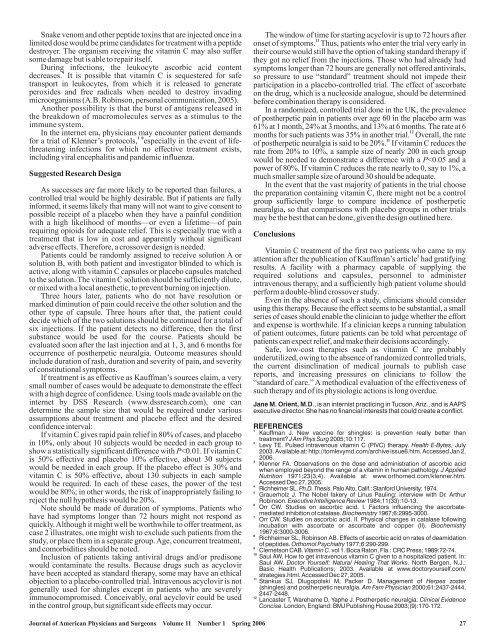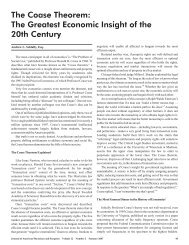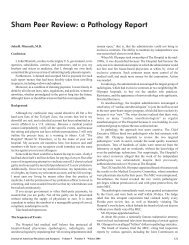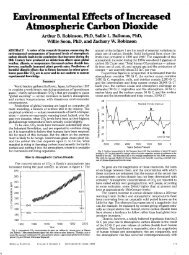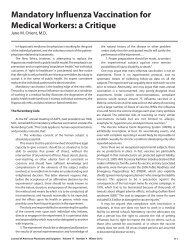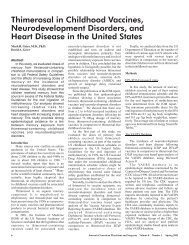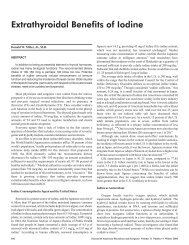Treating with Vitamin C: Two Case Reports Herpes Zoster
Treating with Vitamin C: Two Case Reports Herpes Zoster
Treating with Vitamin C: Two Case Reports Herpes Zoster
You also want an ePaper? Increase the reach of your titles
YUMPU automatically turns print PDFs into web optimized ePapers that Google loves.
Snake venom and other peptide toxins that are injected once in a<br />
limited dose would be prime candidates for treatment <strong>with</strong> a peptide<br />
destroyer. The organism receiving the vitamin C may also suffer<br />
some damage but is able to repair itself.<br />
During infections, the leukocyte ascorbic acid content<br />
9<br />
decreases. It is possible that vitamin C is sequestered for safe<br />
transport in leukocytes, from which it is released to generate<br />
peroxides and free radicals when needed to destroy invading<br />
microorganisms (A.B. Robinson, personal communication, 2005).<br />
Another possibility is that the burst of antigens released in<br />
the breakdown of macromolecules serves as a stimulus to the<br />
immunesystem.<br />
In the internet era, physicians may encounter patient demands<br />
10<br />
for a trial of Klenner’s protocols, especially in the event of lifethreatening<br />
infections for which no effective treatment exists,<br />
including viral encephalitis and pandemic influenza.<br />
Suggested Research Design<br />
As successes are far more likely to be reported than failures, a<br />
controlled trial would be highly desirable. But if patients are fully<br />
informed, it seems likely that many will not want to give consent to<br />
possible receipt of a placebo when they have a painful condition<br />
<strong>with</strong> a high likelihood of months—or even a lifetime—of pain<br />
requiring opioids for adequate relief. This is especially true <strong>with</strong> a<br />
treatment that is low in cost and apparently <strong>with</strong>out significant<br />
adverse effects. Therefore, a crossover design is needed.<br />
Patients could be randomly assigned to receive solution A or<br />
solution B, <strong>with</strong> both patient and investigator blinded to which is<br />
active, along <strong>with</strong> vitamin C capsules or placebo capsules matched<br />
to the solution. The vitamin C solution should be sufficiently dilute,<br />
or mixed <strong>with</strong> a local anesthetic, to prevent burning on injection.<br />
Three hours later, patients who do not have resolution or<br />
marked diminution of pain could receive the other solution and the<br />
other type of capsule. Three hours after that, the patient could<br />
decide which of the two solutions should be continued for a total of<br />
six injections. If the patient detects no difference, then the first<br />
substance would be used for the course. Patients should be<br />
evaluated soon after the last injection and at 1, 3, and 6 months for<br />
occurrence of postherpetic neuralgia. Outcome measures should<br />
include duration of rash, duration and severity of pain, and severity<br />
of constitutional symptoms.<br />
If treatment is as effective as Kauffman’s sources claim, a very<br />
small number of cases would be adequate to demonstrate the effect<br />
<strong>with</strong> a high degree of confidence. Using tools made available on the<br />
internet by DSS Research (www.dssresearch.com), one can<br />
determine the sample size that would be required under various<br />
assumptions about treatment and placebo effect and the desired<br />
confidence interval:<br />
If vitamin C gives rapid pain relief in 80% of cases, and placebo<br />
in 10%, only about 10 subjects would be needed in each group to<br />
show a statistically significant difference <strong>with</strong> P


